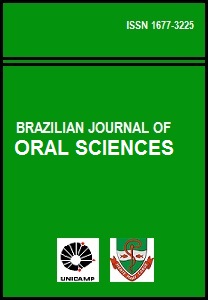Abstract
Temporomandibular disorder (TMD) is one of several somatic manifestations of stress. Several studies have shown that some patients with TMD suffer more anxiety than individuals without this condition. The aim of this study was to identify individuals with TMD and correlate with environmental stress among members of a public university. A proportional stratified probabilistic procedure was used to select 455 subject’s age 17-63 yrs consisted of students, staff and professors. The subjects were enlisted after lunch. TMD were diagnosed using a screening questionnaire based on the American Academy of Orofacial Pain (AAOP). Presence of TMD was defined based on pain in chewing or speaking, tired maxillae and pain in the head, neck and/or teeth. Environmental stress was diagnosed by using the Social Readjustment Rating Scale (SRRS).Gender distribution was similar among undergraduate and graduate students, but there were significant differences in the sex ratio of university staff (66.7% were females) and professors (81.8% were males). Prevalence of TMD influenced by stress among women was significantly greater than in men of the same age group (p=0.0001), and almost all individuals (90.9%) with TMD had a high level of stress (p=0.0082). These findings suggest that there is positive association between TMD and environmental stress.References
Siqueira JTT. Dor orofacial, DTM e cefaléias - diagnóstico diferencial. In: Siqueira JTT, Ching LH, editors. Dor orofacial / ATM bases para o diagnóstico clínico. Curitiba: Editora Maio; 1999. p.83-105.
Dworkin SF, Leresche L, Derouen T, Von Korff M. Assessing clinical signs of temporomandibular disorders: reliability of clinical examiners. J Prosthet Dent. 1990; 63: 574-9.
Ash MM: Current concepts in the aetiology, diagnosis and treatment of TMJ and muscle dysfunction. J Oral Rehábil. 1986; 13: 1-20.
Okeson JP. Avaliação das desordens da dor orofacial. In: Okeson JP, editor. Dor orofacial, guia para avaliação, diagnóstico e tratamento. São Paulo: Quintessence; 1998. p.29-44.
Rugh JD. Psycological components of pain. Dent Clin North Am. 1987; 31: 579-94.
Gerschman JA, Wright JL, Hall WD, Reade PC, Burrows GD, Holwill BJ. Comparisons of psychological and social factors in patients with chronic orofacial pain and dental phobic disorders. Aust Dent J. 1987; 32: 331-5.
Marbach JJ, Raphael KG, Dohrenwend BP, Lennon MC. The validity of tooth grinding measures: etiology of pain dysfunction syndrome revisited. J Am Dent Assoc. 1990; 120: 327-33.
Carlsson GE, DeBoever JÁ. Epidemiologia. In: Zarb GA, Carlsson GE, Sessle BJ, Mohl ND, editors. Disfunções da articulação temporomandibular e dos músculos da mastigação. São Paulo: Santos; 2000. p.159-70.
Manfredi APS, Silva AA, Vendite L. Avaliação do questionário de disfunção temporomandibular, recomendado pela Academia Americana de Dor Orofacial. Rev Bras Otorrinolarigol. 2001; 67: 763-8.
Holmes TH, Rahe RH. The social readjustment rating scale. J Psychos Res. 1967; 11: 213-318.
Lupton DE. Psychological aspects of temporomandibular joint dysfuction. J Am Dent Assoc. 1969; 79: 131-6.
Chrousos GR, Gold PW. The concepts of stress and stress system disorders: overview of physical and behavioral homeostasis. JAMA 1992; 267: 1244-52.
Young EA, Korszun A. Psychoneuroendocrinology of depression: hypothalamic-pituitary-gonadal axis. Psychiatr Clin North Am. 1998; 21: 309-23.
Ferrier IN. Disturbed hypothalamic-pituitary-adrenal axis regulation in depression: causes and consequences. In: Montogmery SA, Corn TH. Physichophisiology of depression. New York: Oxford University Press; 1994. p.47-56.
Oakley ME, McCreary CP, Flack VF, Clark GT, Solberg WK, Pullinger AG. Dentists ability to detect psychological problems with temporomandibular disorders and chronic pain. J Am Dent Assoc. 1989; 118: 727-30.
Warren MP, Fried JL. Temporomandibular disorders and hormones in women. Cells Tissues Organs 2001; 169: 187-92.
Luz JG, Maragno IC, Martin MC. Characteristics of chief complaints of patients with temporomandibular disorders in a Brazilian population. J Oral Rehabil. 1997; 24: 240-3.
Bush FM, Harkins SW, Harrington WG, Price DD. Analysis of gender effects on pain perception and symptoms presentation on temporomandibular pain. Pain. 1993; 53: 73-80.
Young EA. The role of gonadal steroids in hypothalamicpituitary-adrenal axis regulation. Crit Rev Neurobiol. 1995; 9: 371-81.
Pettengill C. A comparison of headache symptoms between two groups: a TMD group and a general dental practice group. Cranio. 1999; 17: 64-9.
Melzack R. Neurophysiological foundations of pain. In: Melzack R. The psychological of pain. 2nd ed. New York: Raven; 1986. p.1-25.
Mazzetto MO. Alterações psicossociais em sujeitos com desordens craniomandibulares. JBA. 2001; 3: 233-243.

This work is licensed under a Creative Commons Attribution 4.0 International License.
Copyright (c) 2015 Ana Paula Sereni Manfredi, Paula Próspero Borelli Bortolleto, Ariovaldo Armando Silva, Izilda Esmênia Muglia Araújo, Sebastião Araújo, Laércio Luis Vendite

